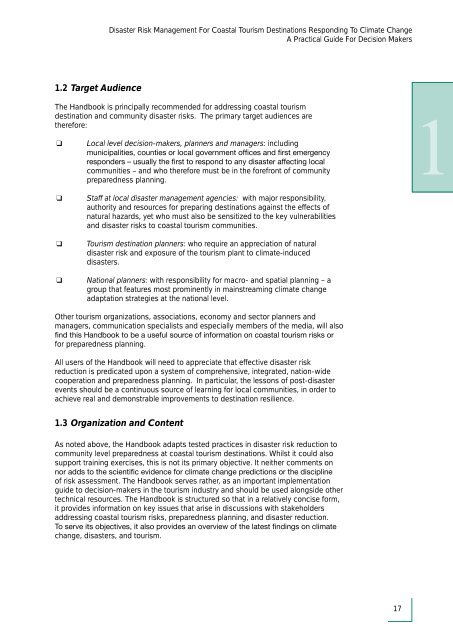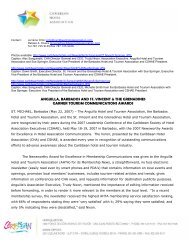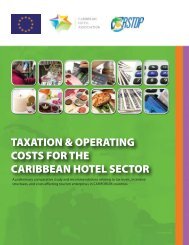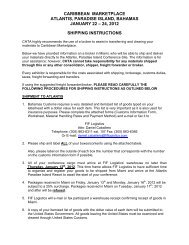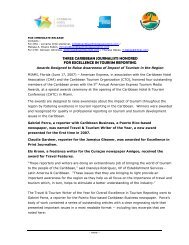Disaster Risk Management for Coastal Tourism - Caribbean Hotel ...
Disaster Risk Management for Coastal Tourism - Caribbean Hotel ...
Disaster Risk Management for Coastal Tourism - Caribbean Hotel ...
You also want an ePaper? Increase the reach of your titles
YUMPU automatically turns print PDFs into web optimized ePapers that Google loves.
<strong>Disaster</strong> <strong>Risk</strong> <strong>Management</strong> For <strong>Coastal</strong> <strong>Tourism</strong> Destinations Responding To Climate Change<br />
A Practical Guide For Decision Makers<br />
1.2<br />
Target Audience<br />
The Handbook is principally recommended <strong>for</strong> addressing coastal tourism<br />
destination and community disaster risks. The primary target audiences are<br />
there<strong>for</strong>e:<br />
<br />
Local level decision-makers, planners and managers: including<br />
<br />
<br />
communities – and who there<strong>for</strong>e must be in the <strong>for</strong>efront of community<br />
preparedness planning.<br />
1<br />
<br />
<br />
<br />
Staff at local disaster management agencies: with major responsibility,<br />
authority and resources <strong>for</strong> preparing destinations against the effects of<br />
natural hazards, yet who must also be sensitized to the key vulnerabilities<br />
and disaster risks to coastal tourism communities.<br />
<strong>Tourism</strong> destination planners: who require an appreciation of natural<br />
disaster risk and exposure of the tourism plant to climate-induced<br />
disasters.<br />
National planners: with responsibility <strong>for</strong> macro- and spatial planning – a<br />
group that features most prominently in mainstreaming climate change<br />
adaptation strategies at the national level.<br />
Other tourism organizations, associations, economy and sector planners and<br />
managers, communication specialists and especially members of the media, will also<br />
<br />
<strong>for</strong> preparedness planning.<br />
All users of the Handbook will need to appreciate that effective disaster risk<br />
reduction is predicated upon a system of comprehensive, integrated, nation-wide<br />
cooperation and preparedness planning. In particular, the lessons of post-disaster<br />
events should be a continuous source of learning <strong>for</strong> local communities, in order to<br />
achieve real and demonstrable improvements to destination resilience.<br />
1.3<br />
Organization and Content<br />
As noted above, the Handbook adapts tested practices in disaster risk reduction to<br />
community level preparedness at coastal tourism destinations. Whilst it could also<br />
support training exercises, this is not its primary objective. It neither comments on<br />
<br />
of risk assessment. The Handbook serves rather, as an important implementation<br />
guide to decision-makers in the tourism industry and should be used alongside other<br />
technical resources. The Handbook is structured so that in a relatively concise <strong>for</strong>m,<br />
it provides in<strong>for</strong>mation on key issues that arise in discussions with stakeholders<br />
addressing coastal tourism risks, preparedness planning, and disaster reduction.<br />
<br />
change, disasters, and tourism.<br />
17


